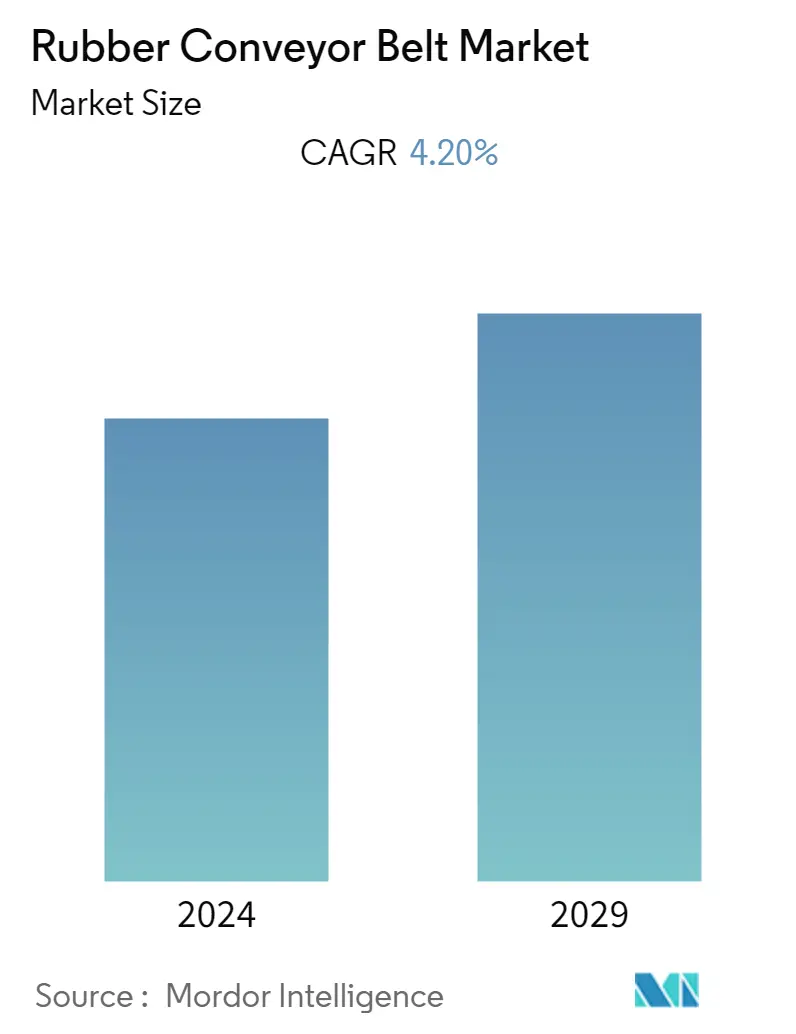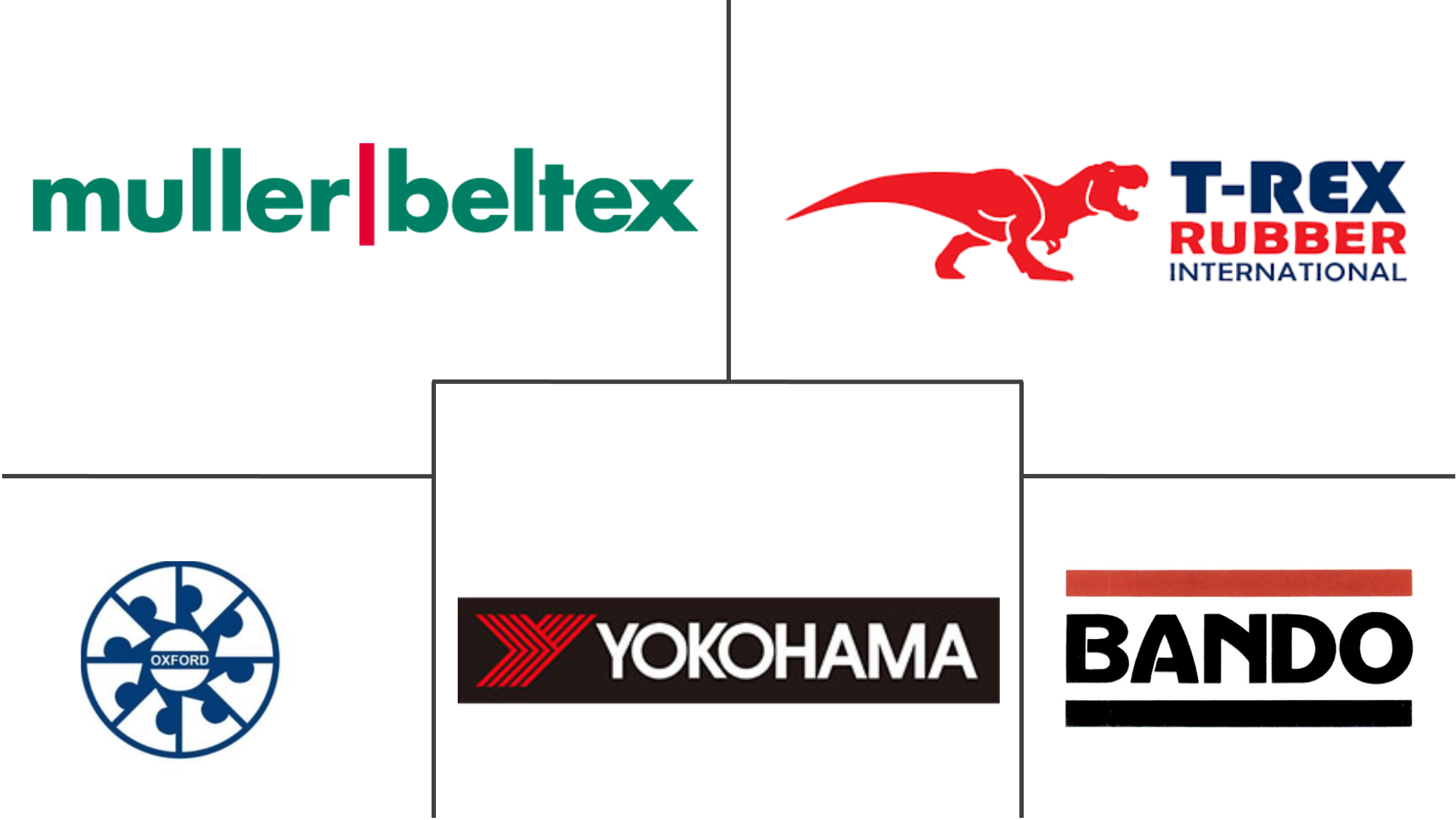Market Size of Rubber Conveyor Belt Industry

| Study Period | 2019 - 2029 |
| Base Year For Estimation | 2023 |
| CAGR | 4.20 % |
| Fastest Growing Market | Asia Pacific |
| Largest Market | Asia Pacific |
| Market Concentration | Low |
Major Players
*Disclaimer: Major Players sorted in no particular order |
Rubber Conveyor Belt Market Analysis
Global Rubber Conveyor Belt Market is expected to register a CAGR of 4.02% over the forecast period (2021 - 2026). The market is witnessing major acquisitions and mergers, which are shaping the market landscape.
- The main driving factor for the rise of conveyor belt usage is the growth of e-commerce industry. Warehouses are proliferating, due to which there is an increasing need for material handling and reducing downtime. US-based SpanTech LLC offers e-commerce conveyors for the automation of e-commerce fulfillment processes.
- Conveyor belts are widely used in a variety of sectors because of their high adaptability, lightweight, and cost-effectiveness. One of the major factors driving the worldwide conveyor belt market is rising demand from the power, mining, and industrial industries.
- Companies in all industries, including manufacturing, mining, electric vehicles, food processing, warehouses, and other material handling facilities, are continuously seeking ways to improve their processes, which has boosted the demand for industrial facility automation. Conveyor belt systems will benefit greatly from the widespread adoption of automation in the workplace.
- However, the market is largely affected by fluctuations in raw material prices, which act as a challenge for market growth. An increase or decrease in rubber prices is dependant mainly on market conditions such as global supply/demand position, crude oil price movements, and the consequent impact on prices of synthetic substitutes.
- The conveyor belt market is witnessing a significant slowdown due to the impact of COVID-19 on the industries. The imposed lockdown and trade restrictions caused the factories and industries to shut down their operations. Moreover, due to the uncertainty, shortage of manpower, and material caused due to the supply chain restrictions, new facilities were also not built during the period, therefore, directly hampering the demand for conveyor belt systems. However, the rise in e-commerce during the period partially improved the conveyor belt demand.
Rubber Conveyor Belt Industry Segmentation
A conveyor belt is used to transport goods from one location to another. They're typically utilised for short-distance movement within a facility, as well as connecting assembly lines to final inspection and packing lines. The material to be conveyed is placed on the belt and transported horizontally or along an inclined slope to its destination. Two or more pulleys are used to rotate the belt in continuous circles in this method. Conveyor belts are widely used in a variety of sectors because to their high adaptability, light weight, and cost-effectiveness. One of the major factors driving the worldwide conveyor belt market is rising demand from the power, mining, and industrial industries.
Rubber conveyor belts can be classified as heat-resistant, oil-resistant, fire-resistant and chemical resistant. They are increasingly being utilized by various end-user industries such as Logistics, Mining, Manufacturing and Metal Processing at various stages.
| By Type | |
| Heat-Resistant | |
| Oil-Resistant | |
| Fire-Resistant | |
| Chemical-Resistant |
| By End-user Industry | |
| Logistics | |
| Mining | |
| Manufacturing | |
| Metal Processing |
| Geography | |
| North America | |
| Europe | |
| Asia-Pacific | |
| Latin America | |
| Middle East & Africa |
Rubber Conveyor Belt Market Size Summary
The rubber conveyor belt market is experiencing a dynamic phase characterized by significant growth driven by the expanding e-commerce sector and the increasing demand for automation across various industries. The adaptability, lightweight nature, and cost-effectiveness of conveyor belts make them indispensable in sectors such as manufacturing, mining, electric vehicles, and food processing. The rise in industrial facility automation is further propelling the demand for conveyor systems. However, the market faces challenges due to fluctuations in raw material prices, particularly rubber, which are influenced by global supply and demand conditions and crude oil price movements. The COVID-19 pandemic initially slowed market growth due to factory shutdowns and supply chain disruptions, but the surge in e-commerce partially mitigated the impact.
In regions like Asia Pacific, the conveyor belt market is witnessing robust growth due to rapid urbanization, technological advancements, and increased industrial activities. The demand for conveyor systems is bolstered by the region's booming e-commerce operations and significant investments in infrastructure and mining. Countries like China and Australia are leading in the adoption of real-time conveyor monitoring systems to enhance operational efficiency. The market is fragmented with numerous end-user industries adopting conveyor belts, and companies are increasingly focusing on innovation and mergers to stay competitive. Technological advancements, such as RFID integration and the development of specialized materials for food-grade belts, are enhancing the functionality and efficiency of conveyor systems, further driving market growth.
Rubber Conveyor Belt Market Size - Table of Contents
-
1. MARKET DYNAMICS
-
1.1 Market Overview
-
1.2 Introduction to Market Drivers and Restraints
-
1.3 Market Drivers
-
1.3.1 Growth of E-Commerce Industry.
-
1.3.2 Increase in Productivity at Manufacturing Facilities.
-
-
1.4 Market Restraints
-
1.4.1 Fluctuations in Raw Material Prices
-
-
1.5 Value Chain Analysis
-
1.6 Industry Attractiveness - Porter's Five Force Analysis
-
1.6.1 Threat of New Entrants
-
1.6.2 Bargaining Power of Buyers/Consumers
-
1.6.3 Bargaining Power of Suppliers
-
1.6.4 Threat of Substitute Products
-
1.6.5 Intensity of Competitive Rivalry
-
-
-
2. MARKET SEGMENTATION
-
2.1 By Type
-
2.1.1 Heat-Resistant
-
2.1.2 Oil-Resistant
-
2.1.3 Fire-Resistant
-
2.1.4 Chemical-Resistant
-
-
2.2 By End-user Industry
-
2.2.1 Logistics
-
2.2.2 Mining
-
2.2.3 Manufacturing
-
2.2.4 Metal Processing
-
-
2.3 Geography
-
2.3.1 North America
-
2.3.2 Europe
-
2.3.3 Asia-Pacific
-
2.3.4 Latin America
-
2.3.5 Middle East & Africa
-
-
Rubber Conveyor Belt Market Size FAQs
What is the current Rubber Conveyor Belt Market size?
The Rubber Conveyor Belt Market is projected to register a CAGR of 4.20% during the forecast period (2024-2029)
Who are the key players in Rubber Conveyor Belt Market?
Oxford Rubbers Pvt. Ltd., Muller Beltex B.V., T-Rex Rubber International B.V., The Yokohama Rubber Co. Ltd. and Bando Chemical Industries Ltd. are the major companies operating in the Rubber Conveyor Belt Market.

